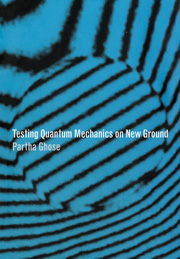Book contents
- Frontmatter
- Contents
- Preface
- Copyright acknowledgements
- 1 Wave-particle duality
- 2 Cavity quantum electrodynamics
- 3 Quantum nondemolition measurements
- 4 Topological phases
- 5 Macroscopic quantum coherence
- 6 The quantum Zeno paradox
- 7 Testing collapse
- 8 Macroscopic quantum jumps
- 9 Nonlocality
- 10 Tunneling times
- References
- Author index
- Subject index
10 - Tunneling times
Published online by Cambridge University Press: 27 October 2009
- Frontmatter
- Contents
- Preface
- Copyright acknowledgements
- 1 Wave-particle duality
- 2 Cavity quantum electrodynamics
- 3 Quantum nondemolition measurements
- 4 Topological phases
- 5 Macroscopic quantum coherence
- 6 The quantum Zeno paradox
- 7 Testing collapse
- 8 Macroscopic quantum jumps
- 9 Nonlocality
- 10 Tunneling times
- References
- Author index
- Subject index
Summary
Introduction
In classical physics it is meaningful to ask the question, ‘How much time does a particle take to pass through a given region?’ The interesting question in quantum mechanics is: does a particle take a definite time to tunnel through a classically forbidden region? The question has been debated ever since the idea that there was such a time in quantum theory was first put forward by MacColl way back in 1932 [253]. A plethora of times has since then been proposed, and the answer seems to depend on the interpretation of quantum mechanics one uses. A reliable answer is clearly of great importance for the design of high-frequency quantum devices, tunnelling phenomena (as, for example, in scanning tunneling microscopy), nuclear and chemical reactions and, of course, for purely conceptual reasons.
Most of the controversies centre around simple and intuitive notions in idealized one-dimensional models in a scattering configuration in which a particle (usually represented by a wave packet) is incident on a potential barrier localized in the interval [a, b]. Three kinds of time have been defined in this context. One, called the transmission time τT(a, b), is the average time spent within the barrier region by the particles that are eventually transmitted. Similarly, the reflection time τR(a, b) is the average time spent within the barrier region by the particles that are eventually reflected.
- Type
- Chapter
- Information
- Testing Quantum Mechanics on New Ground , pp. 165 - 185Publisher: Cambridge University PressPrint publication year: 1999

